This article relies largely or entirely on a single source .(May 2021) |
The 1919 Bavarian state election was held on 12 January and 2 February 1919 to elect the 180 members of the Landtag of Bavaria. [1]
This article relies largely or entirely on a single source .(May 2021) |
The 1919 Bavarian state election was held on 12 January and 2 February 1919 to elect the 180 members of the Landtag of Bavaria. [1]
| Party | Votes | % | Seats | |
|---|---|---|---|---|
| Bavarian People's Party | 1,193,101 | 34.99 | 66 | |
| Social Democratic Party | 1,124,584 | 32.98 | 61 | |
| German People's Party [lower-alpha 1] | 477,992 | 14.02 | 25 | |
| Bavarian Peasants' League | 310,165 | 9.10 | 16 | |
| Bavarian National-Liberal Party [lower-alpha 2] / Bavarian Middle Party / German People's Party in the Palatinate [lower-alpha 3] | 196,818 | 5.77 | 9 | |
| Independent Social Democratic Party | 86,254 | 2.53 | 3 | |
| Others | 20,627 | 0.60 | – | |
| Total | 3,409,541 | 100.00 | 180 | |
| Valid votes | 3,409,541 | 99.38 | ||
| Invalid/blank votes | 21,377 | 0.62 | ||
| Total votes | 3,430,918 | 100.00 | ||
| Registered voters/turnout | 3,977,614 | 86.26 | ||
| Source: Gonschior [1] | ||||

Bavaria, officially the Free State of Bavaria, is a state in the southeast of Germany. With an area of 70,550.19 km2 (27,239.58 sq mi), it is the largest German state by land area, comprising roughly a fifth of the total land area of Germany. With over 13 million inhabitants, it is the second most populous German state, behind only North Rhine-Westphalia, but due to its large land area its population density is below the German average. Major cities include Munich, Nuremberg, and Augsburg.

The German People's Party was a conservative-liberal political party during the Weimar Republic that was the successor to the National Liberal Party of the German Empire. Along with the left-liberal German Democratic Party (DDP), it represented political liberalism in Germany between 1918 and 1933.

Hermann Müller was a German Social Democratic politician who served as foreign minister (1919–1920) and was twice chancellor of Germany during the Weimar Republic.

Wilhelm Marx was a German judge, politician and member of the Catholic Centre Party. During the Weimar Republic he was the chancellor of Germany twice, from 1923–1925 and 1926–1928, and served briefly as the minister president of Prussia in 1925. With a total of 3 years and 73 days, he was the longest-serving chancellor during the Weimar Republic.
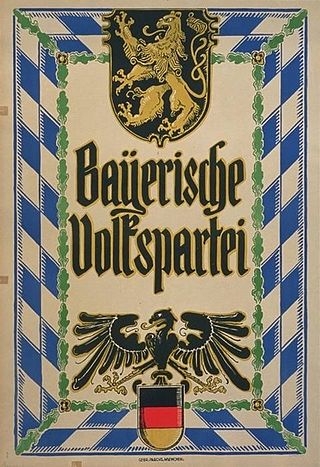
The Bavarian People's Party was a Catholic political party in Bavaria during the Weimar Republic. After the collapse of the German Empire in 1918, it split away from the national-level Catholic Centre Party and formed the BVP in order to pursue a more conservative and particularist Bavarian course. It consistently had more seats in the Bavarian state parliament than any other party and provided all Bavarian minister presidents from 1920 on. In the national Reichstag it remained a minor player with only about three percent of total votes in all elections. The BVP disbanded shortly after the Nazi seizure of power in early 1933.

The Weimar Coalition is the name given to the coalition government formed by the Social Democratic Party of Germany (SPD), the German Democratic Party (DDP) and the Catholic Centre Party (Z), who together had a large majority of the delegates to the Constituent Assembly that met at Weimar in 1919, and were the principal groups that designed the constitution of the Weimar Republic. These three parties were seen as the most committed to Germany's new democratic system, and together governed Germany until the elections of 1920, when the first elections under the new constitution were held, and both the SPD and especially the DDP lost a considerable share of their votes. Although the Coalition was revived in the ministry of Joseph Wirth from 1921 to 1922, the pro-democratic elements never truly had a majority in the Reichstag from this point on, and the situation gradually grew worse for them with the continued weakening of the DDP. This meant that any pro-republican group that hoped to attain a majority would need to form a "Grand Coalition" with the conservative-liberal German People's Party (DVP), which only gradually moved from monarchism to republicanism over the course of the Weimar Republic and was virtually wiped out politically after the death of their most prominent figure, Foreign Minister Gustav Stresemann in 1929.
In the fourteen years the Weimar Republic was in existence, some forty parties were represented in the Reichstag. This fragmentation of political power was in part due to the use of a peculiar proportional representation electoral system that encouraged regional or small special interest parties and in part due to the many challenges facing the nascent German democracy in this period.
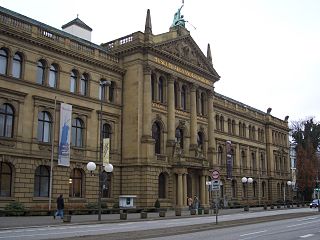
The Parlamentarischer Rat was the West German constituent assembly in Bonn that drafted and adopted the constitution of West Germany, the Basic Law for the Federal Republic of Germany, promulgated on 23 May 1949.

Presidential elections were held in Germany on 29 March 1925, with a runoff on 26 April. They were the first direct elections to the office of President of the Reich, Germany's head of state during the 1919–33 Weimar Republic. The first President, Friedrich Ebert, who had died on 28 February 1925, had been elected indirectly, by the National Assembly, but the Weimar Constitution required that his successor be elected by the "whole German people". Paul von Hindenburg was elected as the second president of Germany in the second round of voting.

Johannes Hoffmann was a German politician and member of the Social Democratic Party from Bavaria. He served as a Minister in the revolutionary government of the Bavarian Soviet Republic and subsequently in the People's State of Bavaria administration, 1919–20.
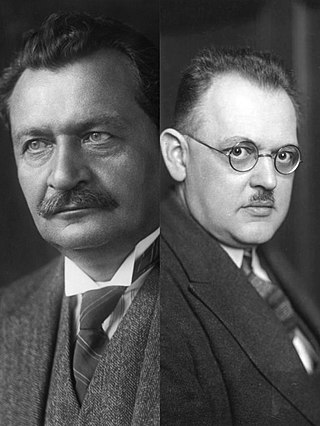
The 1920 German federal election was held on 6 June 1920 to elect the first Reichstag of the Weimar Republic. It succeeded the Weimar National Assembly elected in January 1919, which had drafted and ratified the republican constitution. The election was delayed in three electoral districts – Schleswig-Holstein and East Prussia until 20 February 1921, and Upper Silesia (Oppeln) until 19 November 1922 – due to territorial plebiscites.
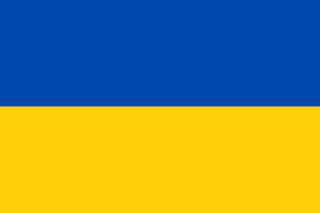
The Free State of Brunswick was a state of the German Reich in the time of the Weimar Republic. It was formed after the abolition of the Duchy of Brunswick in the course of the German Revolution of 1918–19. Its capital was Braunschweig (Brunswick). In 1933 it was de facto abolished by Nazi Germany. The free state was disestablished after the Second World War in 1946.
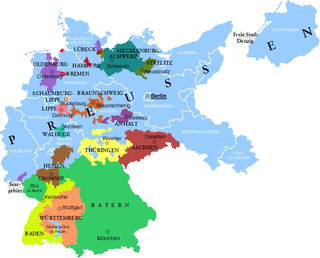
Landtag elections in the Free State of Bavaria (Freistaat Bayern) during the Weimar Republic were held at irregular intervals between 1919 and 1932. Results with regard to the total vote, the percentage of the vote won, the number of seats allocated to each party and the change in distribution of seats are presented in the tables below. On 31 March 1933, the sitting Landtag was dissolved by the Nazi-controlled central government and reconstituted to reflect the distribution of seats in the national Reichstag. The Landtag subsequently was formally abolished as a result of the "Law on the Reconstruction of the Reich" of 30 January 1934 which replaced the German federal system with a unitary state.

The Weimar National Assembly, officially the German National Constitutional Assembly, was the popularly elected constitutional convention and de facto parliament of Germany from 6 February 1919 to 21 May 1920. As part of its duties as the interim government, it debated and reluctantly approved the Treaty of Versailles that codified the peace terms between Germany and the victorious Allies of World War I. The Assembly drew up and approved the Weimar Constitution that was in force from 1919 to 1933. With its work completed, the National Assembly was dissolved on 21 May 1920. Following the election of 6 June 1920, the new Reichstag met for the first time on 24 June 1920, taking the place of the Assembly.
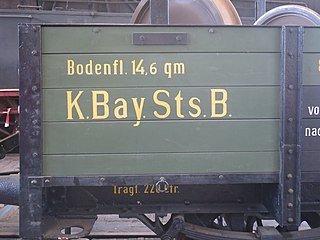
The Royal Bavarian State Railways was the state railway company for the Kingdom of Bavaria. It was founded in 1844. The organisation grew into the second largest of the German state railways with a railway network of 8,526 kilometres by the end of the First World War.
The Brunswick State Electoral Association was a regional electoral alliance active between 1918 and 1922 in the Free State of Brunswick during the Weimar Republic.

The second Stresemann cabinet, headed by Chancellor Gustav Stresemann of the German People's Party (DVP), was the ninth democratically elected government of the Weimar Republic. It took office on 6 October 1923 when it replaced the first Stresemann cabinet, which had resigned on 3 October over internal disagreements related to increasing working hours in vital industries above the eight-hour per day norm. The new cabinet was a majority coalition of four parties from the moderate left to centre-right.
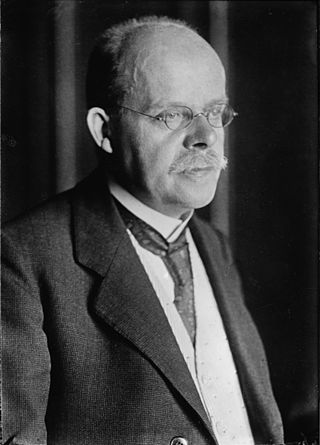
The first Marx cabinet, headed by Wilhelm Marx of the Centre Party, was the tenth democratically elected government during the Weimar Republic. It took office on 30 November 1923 when it replaced the Second Stresemann cabinet, which had resigned on 23 November after the Social Democratic Party (SPD) withdrew from the coalition. Marx's new cabinet was a minority coalition of three centre to centre-right parties.

Gerhard Theodor Alexander Graf von Kanitz was a German politician of the German National People's Party (DNVP) and the German People's Party (DVP). He was a member of several Prussian and German Parliaments and served as Weimar Germany's Minister of Food and Agriculture from 1923 to 1926

Marie Bernays was a German politician, educator, writer and women's rights activist. She co-founded the Mannheim Women's Social School and served in the Landtag of the Republic of Baden from 1921 until 1925 as a member of the Deutsche Volkspartei.